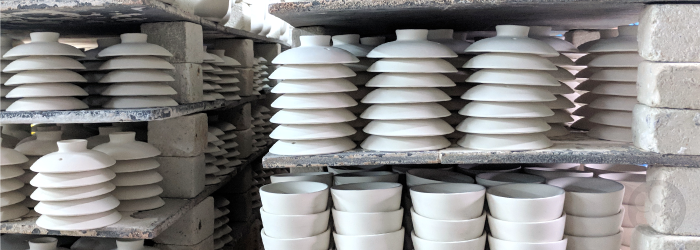Types of Teaware: What is Stoneware Clay?

As if choosing a tea wasn’t hard enough, teaware options are almost equally endless, and can have a surprisingly large impact on the flavor of brewed tea. While many teaware options are made of modern materials like plastic, metal, or glass, the greatest variety of tea tools are made from ceramic, or fired clay. From traditional teapots to utilitarian infusers and decorative display pieces, the clay used to form each piece helps define how it functions.
Pick the perfect brewing tool for your favorite tea >>
In English, clays are divided into three basic categories: earthenware, stoneware, and porcelain. While each encompasses a wide range of raw materials, they are grouped by the approximate temperature they reach during firing, and the resulting density of the final product. This density plays a large part in determining the durability, thickness, and heat retention of any clay.
Earthenware clays are fired to the lowest range of temperatures, leaving the clay molecules hardened, but porous enough to absorb water. Porcelain clays are fired to the highest temperatures, resulting in a very dense and glass-like final product. But most teaware is made from clays fired to the middle range of approximately 1,100 °C (2,010 °F) to 1,300 °C (2,370 °F), which are called stoneware.
In fact, because stoneware is more durable than earthenware, but significantly easier to make and fire than porcelain, it is the most popular type of clay for most applications. Earthenware clays, like terra cotta, are the easiest to produce, but their low density leaves them particularly vulnerable to chipping and breakage. Low firing temperatures mean these clays often retain dark, vibrant colors (though not all dark clays fall into this category).
Porcelain, on the other hand, can be exceptionally durable, but must be made from specific materials to withstand the highest firing temperatures. First developed in Jingdezhen, China, the unique properties of porcelain were the subject of worldwide envy until the early 18th century, when the first high-fired version was created in Europe. Even today, the composition of porcelain clays make them harder to form, and more prone to cracking during firing. The final product, however, can be much thinner than other clays, offering more control over brewing temperatures.
Learn more about the four types of porcelain clay >>
As the perfect middle ground between the two, stoneware clays are used for everything from everyday tableware to artistic sculpture. It can come in a full range of colors and textures, from smooth to sandy, or from nearly-white to completely black, depending on the unique combination of minerals in the clay. Though stoneware pieces can’t rival the delicacy of super-thin porcelain, they are often preferred for darker teas, since their thicker walls retain heat well over the course of multiple infusions.
For a surface that is easy to clean and fully flavor-neutral, pieces are usually coated in a thin layer of glassy glaze, which seals the surface and can contain colorants for aesthetic purposes. Without glaze, stoneware retains some measure of porosity: not enough to absorb moisture as earthenware might, but enough for the mineral composition of the clay to affect flavor, and for the rough surface to acquire a patina from the tannins present in tea. The distinction between glazed and unglazed clay is one of the most important to consider when investing in new teaware, as unglazed clay can have a muting effect on the aromatic notes of any tea.
Learn more about how to use unglazed teapots from Yixing >>
Confusingly, there is no term for ‘stoneware’ in Chinese, so all clays in this firing range are also called porcelain by Chinese sources. In this context, clays that we would call stoneware in English can be distinguished by thicker walls, colors other than white, or a rougher surface. Yixing clays, for instance, fall into the English category of stoneware, but would be categorized as porcelain by Chinese speakers.
Though earthenware, stoneware, and porcelain each encompass a broad swath of specific clays, a basic understanding of these clay types and their general properties can make it easier to shop for practical teaware options.
What type of clay is your favorite teaware made of? What makes it great for brewing tea? Let us know in the comments below!
Sign up for our newsletter to get blog updates in your inbox!







Comments on this post (0)